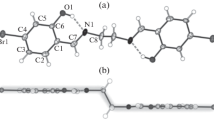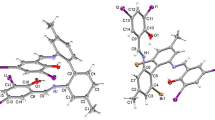Abstract
Asymmetric salen-type Schiff base ligands have been synthesized via a stepwise approach. In the first step, mono-Schiff base compounds were prepared by condensation of salicylaldehyde, 2-hydroxy-3-methoxybenzaldehyde, 2-hydroxy-5-methoxybenzaldehyde and 2-hydroxy-1-naphthaldehyde with hydrazine hydrate. These compounds were then reacted with 4′-formylbenzo-15-crown-5 to prepare asymmetric ligands. 1H-NMR spectra indicate that the mono- and asymmetric bis-Schiff base compounds exist in both (E) and (Z) isomeric forms in CDCl3 solution. The asymmetric crown compounds form crystalline 1:1 (Na+:ligand) complexes with sodium perchlorate. Homo-metallic Ni(II) and Zn(II) complexes with 1:2 (metal:ligand) stoichiometries have also been synthesized. The results indicate that the Schiff base ligands coordinate through the azomethine nitrogen and phenolic oxygen.



Similar content being viewed by others
References
Dominiak PM, Grech E, Barr G, Teat S, Mallinso P, Wozniak K (2003) Chem Eur J 9:963
Fukuda H, Amimoto K, Koyama H, Kawato T (2003) Org Biomol Chem 1:1578
Lu X-X, Qin S-Y, Zhou V, Yam W-W (2003) Inorg Chim Acta 346:49
Boghaei DM, Mohebi S (2002) Tetrahedron 58:5357
Sarkar S, Dey K, Biswas S, Bhaumık BB (2007) J Coord Chem 60:1143
Li J-Z, Xu B, Li S-X (2005) Trans Met Chem 30:666
Galic N, Cimerman Z, Tomisic V (1997) Anal Chim Acta 343:135
Cimerman Z, Kiralj R, Galic N (1994) J Mol Struct 323:7
Cerchiaro G, da Costa Ferreira AM (2006) J Braz Chem Soc 17:1473
Sreerama SG, Mukhopadhyay A, Pal S (2006) Inorg Chem Commun 9:1083
Karakaplan M, Aral T (2005) Tetrahedron Asymmetr 16:2119
Hayvali M, Hayvali Z (2004) Synt React Inorg Met Org Chem 34:713
Kleinpeter E, Starke I, Strohl D, Holdt H-J (1997) J Mol Struct 404:273
Hayvali Z, Gündüz N, Kilic Z, Weber E (1999) J Prakt Chem 341:568
George W, Gokel D (1984) Inorg Chim Acta 82:101
Kwiatkowowski E, Kwiatkowowski M (1980) Inorg Chim Acta 42:197
Calverley M, Dale J (1982) Acta Chem Scan B 36:241
Pedersen CJ (1967) J Am Chem Soc 89:7017
Hyde EM, Shaw BL, Shepherd I (1978) J Chem Soc Dalton Trans 1696
El -Medani SM, Aboaly MM, Abdalla HH, Ramadan RM (2004) Spect Lett 37:619
Sousa C, Freire C, de Castro B (2003) Molecules 8:894
Hayvali Z, Gündüz N, Kilic Z, Weber E (2000) Z Naturforsch 55b:975
Fenton DE, Perkin D (1981) J Chem Soc Perkin Trans 1:449
Hayvali Z, Hayvali M, Kilic Z, Hökelek T, Weber E (2003) J Incl Phenom Macrocycl Chem 45:285
Hayvali Z, Hayvali M, Kilic Z, Hökelek T (2001) J Mol Struct 597:223
Sanz D, Ponce MA, Claramunt RM, Castano CF, Foces C, Elguero J (1999) J Phys Org Chem 12:455
Hayvali Z (2003) Asian J Chem 15:877
Hayvali Z, Hayvali M, Dal H (2004) Molecules 9:860
Yıldız M, Kilic Z, Hökelek T (1998) J Mol Struct 441:1
Salman SR, Kamounah FS (2002) Spect Lett 35:327
Rozwadowski Z, Schilf W, Kamienski B (2005) Magn Reson Chem 43:573
Unver H, Kendi E, Güven K, Durlu TN (2002) Z Naturforsch 57b:685
Sharif S, Powell DR, Schagen D, Steiner T, Toney MD, Fogle E, Limbach HH (1999) Biochemistry 38:311
Yildiz M, Unver H, Erdener D, Ocak N, Erdonmez A, Durlu TN (2006) Cryst Res Technol 41:600
Acknowledgements
The authors gratefully acknowledge the financial support of the Scientific and Technical Research Council of Turkey (TUBITAK), Grant number TBAG 107T002 and Ankara University Research Fund, Grant number 20020705070.
Author information
Authors and Affiliations
Corresponding author
Rights and permissions
About this article
Cite this article
Hayvali, Z., Yardimci, D. Synthesis and spectroscopic characterization of asymmetric Schiff bases derived from 4′-formylbenzo-15-crown-5 containing recognition sites for alkali and transition metal guest cations. Transition Met Chem 33, 421–429 (2008). https://doi.org/10.1007/s11243-008-9060-4
Received:
Accepted:
Published:
Issue Date:
DOI: https://doi.org/10.1007/s11243-008-9060-4




